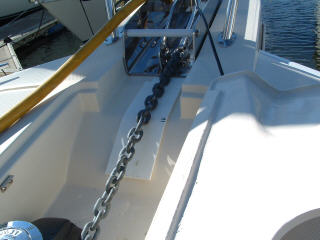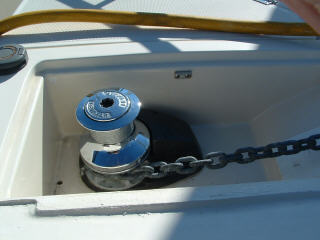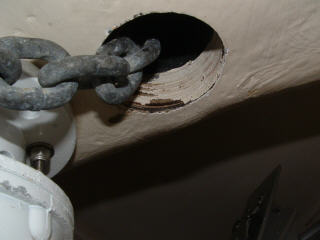The Windlass
The windlass set up on the 400 sacrifices functionality for aesthetics. It is mounted below deck level for a very clean looking deck. It is gorgeous, but very noisy and rough if using a chain rode and not very good as a rope winch for hauling a second anchor.
For a number of reasons we switched to an all chain rode for the first 120 feet of rode last year. I felt this would eliminate the chain/nylon interface problems for 95% of our anchoring. This presented a whole new set of problems we hadn't noticed with the nylon rode. The windless is mounted in a well, with the chain feeding uphill at about a 9 degree angle to the gypsy, over a fiberglass corner before paying out to the roller and overboard. Two problems exist right away. First, this is about the maximum feed angle to the gypsy allowed by the Lewmar specifications and is far from ideal. The ideal setup would have the chain feed on the same plane as the gypsy. Feeding at an angle creates much friction and abrasion on that side of the gypsy resulting in noise and wear. This is the biggest problem for me. The second problem, is feeding chain up & down the ramp, and over the corner to the roller, will wear a trough through the gelcoat and fiberglass in no time. This second problem is easily addressed with a sacrificial wear strip of 1/4" starboard bent and glued to the ramp.
 |
 |
| 1/4" thick starboard was heated and glued down with marine 3M 5200 sealant. If replacement becomes necessary, the sealant can be softened with a heat gun and removed. |
This picture shows the depth of the well, and angle of the chain to the gypsy. |
Another problem is hauling a second anchor using the capstan. Any sailor knows the winch should always be feed from a plane below the drum to avoid override of the line on the drum. Mainship might have done well if they had asked someone from the Hunter sailboat division to help them with the design of this system, because they haven't got a clue. The whole system can be fixed by tipping back the windless so it is fed perpendicular to the gypsy. This can be accomplished by changing the bottom of the well (or the mounting base for the windless) to be on a slope to the top edge of the forward end of the well.
I don't know how I will fix Stella Blue yet, or, if I will just have to live with it. I will present it to Mainship and see what they say. For now, I will go back to nylon rode which run fairly smooth though the windless but tends to twist up because of the angle to the gypsy.
 |
 |
Another thing that owners should look at is the hole cut though the well into the rode locker. Mainship has smeared a little gelcoat over the plywood cut edge, but that comes off pretty quick after running a little chain through there. The windless should be removed and a proper hawse pipe fitted and sealed to keep the plywood from rotting someday.
See Anchoring for more
